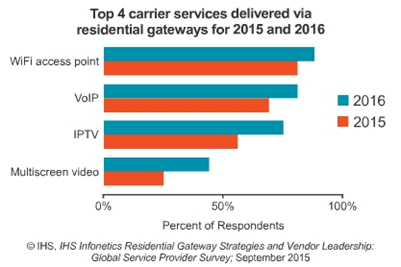 「接続時間の短縮やトラックロールの除去など、家庭における住居用ゲートウェイをバーチャル化するメリットがあるのは明らかですが、当社が実施した調査の回答によると今後数年で実施する施策として誰もが納得しているものではないようです。回答企業の約70%は2017年までのゲートウェイのバーチャル化について計画なし、もしくはわからないとしています」と、IHSでブロードバンドとペイテレビを担当しているリサーチディレクターのJeff Heynen氏は述べている。
「接続時間の短縮やトラックロールの除去など、家庭における住居用ゲートウェイをバーチャル化するメリットがあるのは明らかですが、当社が実施した調査の回答によると今後数年で実施する施策として誰もが納得しているものではないようです。回答企業の約70%は2017年までのゲートウェイのバーチャル化について計画なし、もしくはわからないとしています」と、IHSでブロードバンドとペイテレビを担当しているリサーチディレクターのJeff Heynen氏は述べている。「バーチャル化がある程度実施されてきたデータセンターとは異なり、サービスプロバイダーが住居用の接続ネットワークやCPEをバーチャル化するまでには時間がかかるでしょう」と、Heynen氏は続けて述べている。 住居用ゲートウェイ調査のハイライト
- 住居用ゲートウェイ(RG)はDSL、FTTH、ケーブルもしくは3G/LTEモデムをルーター・スィッチ機能、WiFiアクセスポイントと組み合わせる。サービスプロバイダーが音声、データ、ビデオサービスを提供するのに広く活用されている。
- 回答企業の75%は現在、ギガビットEthernet接続を住居用ゲートウェイで提供している。2016年には88%まで増加するだろう。
- IHSが調査した無線インタフェースの中では802.11acの成長が最も著しく、回答企業の69%が来年までにこれを住居用ゲートウェイに加える計画である。
- 昨年の調査結果と同様にArrisは住居用ゲートウェイベンダーのトップ企業として認識されている。昨年同様、Paceがこれに続いている。
Operators Split on Virtualizing Broadband Residential Gateways [[[ Campbell, CALIFORNIA (September 17, 2015)-]]] IHS conducted in-depth interviews with service providers across the globe who use residential gateways to provide broadband services and found that only 31 percent of respondents plan on virtualizing their residential gateways by 2017. "Despite the obvious benefits of virtualizing residential gateways in the home-namely shortening of provisioning time and elimination of truck rolls-our survey respondents aren't completely convinced it's something they will implement in the next couple of years. Nearly 70 percent said they weren't planning on doing so or didn't know if they would be virtualizing their gateways by 2017," said Jeff Heynen, research director for broadband access and pay TV at IHS.
"Unlike the data center, where virtualization has been in place for some time, it will take longer for service providers to virtualize their residential access networks and CPE," Heynen said. RESIDENTIAL GATEWAY SURVEY HIGHLIGHTS
- Residential gateways (RGs) combine a DSL, FTTH, cable or 3G/LTE modem with routing and switching capabilities and a WiFi access point, and are increasingly used by service providers to deliver voice, data and video services
- 75 percent of respondents currently offer Gigabit Ethernet connections on residential gateways, growing to 88 percent in 2016
- Among the wireless interfaces IHS asked about, 802.11ac shows the most growth, with 69 percent of respondents saying they plan to include it in their residential gateways by next year
- Consistent with last year's findings, Arris topped the list of perceived top residential gateway vendors, followed once again by Pace

